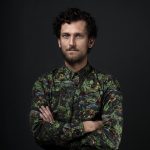Ruben is a concept developer and graphic designer at buro RuSt and has been involved with Fair Wear Foundation for ten years.
A few years ago I decided that with my design studio I only wanted to work for clients that contribute to the world in a positive way. Now my clients are musea, NGOs schools, theatres and artists. To make the kind of designs that I think are good, that help putting ideas across and explain complex issues, I want to understand the material I’m working with. And if possible, agree with it.
The moment I doubted the work of Fair Wear Foundation was just before I really understood it. After working as a concept developer and graphic designer for FWF for some time I asked myself: what are these few brands really going to change in the total picture of the thoroughly rotten garment industry? Even for workers that produce clothing for FWF brands the situation is, although better, not perfect at all. The answer to this question is: proof of concept. You have to show working examples to make a higher level change.
To a large extend, those examples are there now. Not only for social sustainability, but also concerning environmental problems: we know what needs to be done.
All around us new technology is emerging. Which makes the possibilities to make big system changes larger than ever.
In my work I always try to either simplify or exaggerate problems to come up with solutions that are outside the normal line of thinking. To look for techniques, stories, methods and ideas from other playing fields and introduce them in the area we’re working in. Often with surprising results, even for myself.
I’ve looked into what makes the wings of butterflies so shiny, and what causes people’s stripy shirts on TV to go mad. This resulted in a seemingly ever-changing coloured cover of a booklet for an orchestra.
For this project I’m very interested to find people that have ideas, methods, techniques, materials, language, designs, that don’t necessarily offer solutions for the big problems in the garment industry yet, but have big possibilities when placed in the context of garment production.
For instance a pilot that uses the Indian technology called AADHAAR ID-system for the benefit of cocoa farmers. In general, none of the added value generated through processing their crops flows back to them. They earn the lowest income of the chain. But if they can put their cocoa in a blockchain-based system, they are suddenly able to cooperate and rent machines to do the next step in the chain. Normally they can’t rent these machines, because the owner is not sure the farmer can and will pay for it. Now the system provides a security that the farmer will earn more (the processed cocoa), and the machine owner will get paid (the money is anchored in the blockchain).
Another example that wouldn’t have been possible some years ago: A cooperative occupational disability insurance: a group of 50 peers that simply give each other some money if one of them is sick (called a broodfonds or breadfund).
The use of new technology makes these social, transparent and honest ideas possible.
My work in The Threads will be to visually explain ideas so that they emerge as clearly as possible. So that we and others can use these ideas, maybe not even in the field they were meant for. And on the other hand I’ll play a role in treasure hunting and discovering the ideas, methods, and technologies I mentioned earlier. I want to put them in such a context that it will make our collective vision on the garment industry clearer. And help kickstart real big changes.

